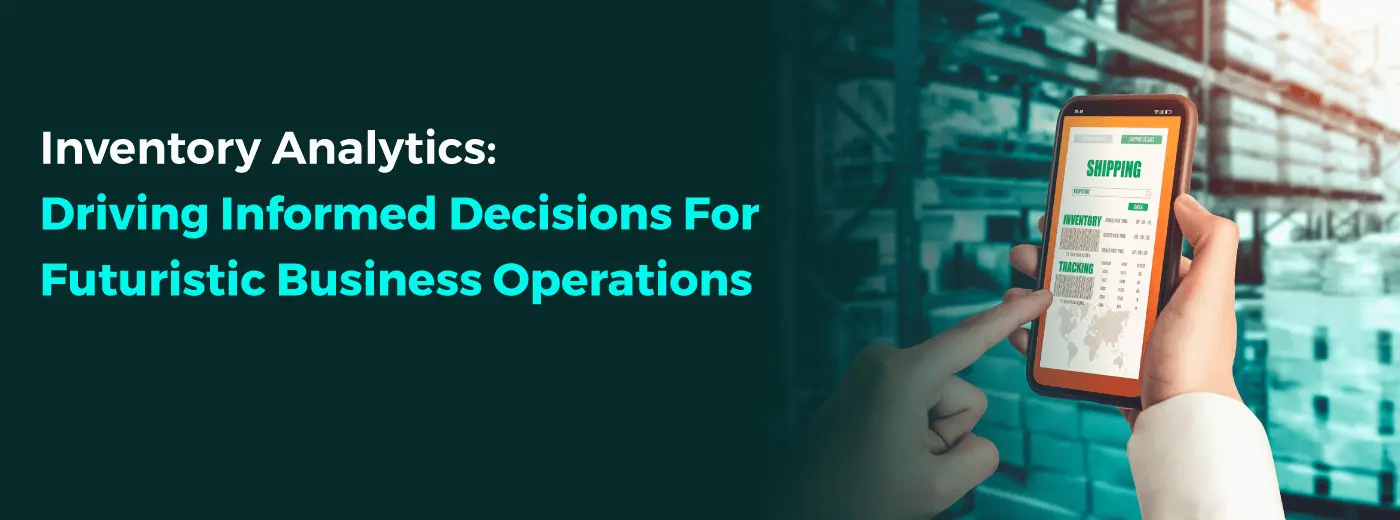Editor’s Note: Driven by increasing demand for competitive efficiency, today’s inventory management goes beyond ensuring accurate inventory and automating key business processes. Today’s inventory control systems hold the key to powering business insights that can help you make data-driven decisions for increased productivity and profitability.
This blog post will discuss why inventory analytics is essential, what businesses need, its benefits, and its best practices
Introduction
We are on the verge of a critical upheaval in managing inventory. This revolution results from the availability of vast amounts of real-time data that are now routinely generated on the internet and through the interconnected world of enterprise software systems and smart products. Managers must redesign their supply-chain processes to use this new data effectively and stay competitive.
We are talking about going beyond using traditional historical data on past sales and stockouts. It is now possible to link data generated by all product interactions (including orders, examinations, and reviews by actual and potential customers) and transactions generated by suppliers and competitors who connect via internet websites and cloud portals. Material-management systems can use this data to control the ordering and distribution of products throughout a company's extended supply chain.
To keep things running smoothly, you'll need to track your inventory levels closely and make decisions accordingly. That's where inventory analysis comes in. By analyzing your inventory data, you can better decide what to produce, how much, and when to produce it.
This article will discuss why inventory analytics is essential, what businesses need, its benefits, best practices, and how an organization like Polestar Solutions can help you streamline your inventory management process.
Understanding the Dynamics of Inventory Analytics
Inventory analytics refers to tracking metrics that gauge the performance and movement of your physical products. The ongoing assessment and evaluation of inventory provide the insights required to optimize stock availability to meet demand while keeping storage expenses to a minimum.
Inventory analysis also assists in reducing risks and common challenges related to inventory, such as stockouts or accumulating dead stock, and uses technology and processes to ensure inventory accuracy. It is critical to managing logistics operations and can improve inventory control, supply chain efficiency, and profitability.
The Crucial Role of Inventory Analytics in Business Growth
Inventory management can be a hassle if businesses need the right tools to monitor product activity. As supply chains expand, this task becomes even more challenging, as companies need to orchestrate manufacturing, distribution, and retail. Inventory analytics provides critical insights into product management, so businesses can practice cost reduction and improve operations. However, studies show that only 34.7% of supply chains take advantage of inventory analytics simply because many companies must be aware of its existence.
With adequate inventory analytics, companies can efficiently track products as they work their way through the supply chain. This can result in discrepancies, unhealthy stock levels, and backorder. On the other hand, inventory analytics utilizes modern software so companies can enhance their control. These solutions use machine learning to collect relevant real-time and historical data from existing systems to update inventory reports and metrics.
When coupled with demand forecasting software, predictive analytics can project future sales and safety stock needs for inventory optimization. This ensures that businesses can satisfy fluctuating customer demand and maintain healthy inventory levels by anticipating emerging trends. With analytics data, companies can also improve business intelligence with sophisticated data science to improve product handling.
Stay connected and get real-time insights on the inventory status, no matter where you are with our analytics consulting approach.
Game-Changing Advantages of Inventory Analytics
Many benefits come with analyzing your inventory data, but here are a few of the most important ones:
Make better decisions: By understanding what products are selling well and which aren't, you can adjust your production accordingly. This can help you save money on inventory that isn't moving and increase profits by focusing on items in high demand.
Reduce the risk of stockouts: No one wants to run out of a product their consumers want to buy. Recent data makes a suggestion that 37% of customers will go to another brand if they experience a stockout. By minutely analyzing the inventory, the chance of these disasters will be minimized.
Save expense on storage and shipping costs: Carrying too much inventory can be expensive, both in terms of the physical space it takes and the money that organizations spend shipping it from one geography to another. By analyzing the inventory data, you can better understand how much inventory you require to keep on hand.
Save time: Tracking your inventory manually can be time-taking and error-prone. But if you utilize software, you can automate numerous tasks involved in inventory management analysis and free up your time, so that you can put more focus on other aspects of running your business in a smooth way.
Improving customer satisfaction: If you have a good hold on your inventory levels, you are more likely to be able to fulfil consumer orders in a stipulated time, leading to happier customers and improved customer satisfaction.
Best Practices in Inventory Management Analytics
By initiating analytics best practices, finding the right talent, and adopting enabling tech, companies can save money on data efforts that steer them right. Best practices involve:
Centralizing data: When data comes in a single system Vs a disconnected silo, all stakeholders can collaborate and communicate across departments.
Classify inventory: All inventory items should be categorized or classified for easy monitoring. Classification may start with the ABC ranking, where A-products are the most closely monitored as they have a significant impact on profit gains. B products don't contribute to profit as much as A items, while C products account for the smallest gains. Then drill down into more granular details, such as electronics, apparel, home goods, and outdoor. Classification allows you to view data based on a variety of parameters.
Obtain accurate information across systems: Utilizing technology to centralize the data concerned to numerous moving parts of the supply chain will make sure that the info on which the organization is basing decisions is complete and accurate.
Use real-time dashboards: What is apt for data if it's not current? In inventory management, businesses always want to know current inventory levels to calculate the requirements and perform forecasting accurately. Technology solutions that provide real-time, valuable metrics in a centralized view to make it easy for staff and leadership to view productivity and status quickly.
Real World Inventory Analytics Examples of Successful Corporations
Apple
Apple is a company known for its innovative products and cutting-edge technology. However, many people need to learn that Apple has a very efficient Inventory Management analytics team behind the scenes. The company uses Inventory analysis techniques to track stock levels and forecast future demand. This helps them ensure that they always have enough stock on hand while avoiding overstocking. As a result, Apple has maintained high customer satisfaction while keeping its inventory costs low.
Toyota
Toyota is another company that is well-known for its efficient Inventory Management. The automaker uses various tools, such as Kanban cards and inventory forecasting software, to track stock levels and plan production. This allows Toyota to ensure they always have the right amount of parts on hand while minimizing waste. As a result, Toyota has maintained a high-quality level while keeping its inventory costs low.
Glossier
Glossier is a cosmetics company known for its high-quality products and trendy designs. The company has achieved this by using an Inventory Management system based on demand forecasting. Glossier forecasts the demand for each product and then produces only the needed amount. This system has allowed Glossier to keep its inventory costs low while offering a large selection of products.
How can you use Polestar Solutions Inventory Analytics to Optimize Business Performance
Inventory analytics systems highlight what is right and wrong and how to improve inventory management. Polestar Solutions' robust inventory management solution offering real-time, customizable inventory analytics to accelerate business success.
With the apt foundational data, modern inventory management systems can utilize analytics to answer "what should we do" to improve customer satisfaction, maximize profits and reduce costs. Looking for a configurable inventory management solution that integrates with all of your business systems? Here we are; book a demo today!



